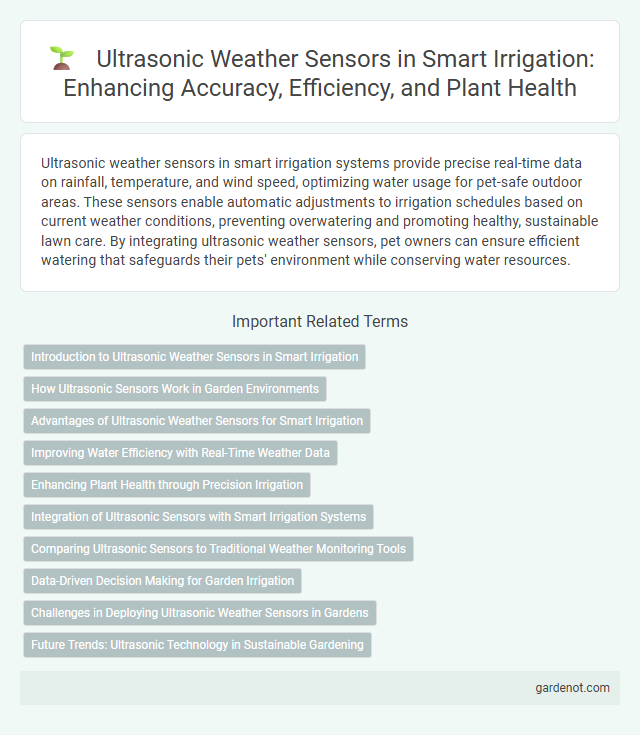Ultrasonic weather sensors in smart irrigation systems provide precise real-time data on rainfall, temperature, and wind speed, optimizing water usage for pet-safe outdoor areas. These sensors enable automatic adjustments to irrigation schedules based on current weather conditions, preventing overwatering and promoting healthy, sustainable lawn care. By integrating ultrasonic weather sensors, pet owners can ensure efficient watering that safeguards their pets' environment while conserving water resources.
Introduction to Ultrasonic Weather Sensors in Smart Irrigation
Ultrasonic weather sensors in smart irrigation systems utilize high-frequency sound waves to measure environmental parameters such as wind speed, temperature, and humidity with high precision. These sensors enable accurate, real-time weather monitoring, allowing irrigation controllers to adjust water delivery based on current atmospheric conditions, thus optimizing water usage and improving crop health. By integrating ultrasonic data, smart irrigation enhances efficiency and sustainability, reducing water waste and adapting to microclimatic variations within agricultural fields.
How Ultrasonic Sensors Work in Garden Environments
Ultrasonic weather sensors operate by emitting high-frequency sound waves that bounce off nearby objects, measuring the time taken for the echoes to return, which determines the distance to surfaces such as plants and soil. In garden environments, these sensors monitor parameters like wind speed and precipitation by detecting changes in sound wave transmission caused by weather elements. This real-time data enables precision smart irrigation systems to adjust watering schedules efficiently, conserving water while maintaining optimal soil moisture levels.
Advantages of Ultrasonic Weather Sensors for Smart Irrigation
Ultrasonic weather sensors enhance smart irrigation by providing precise measurements of wind speed and direction, temperature, and humidity, enabling accurate microclimate monitoring. Their non-contact sensing technology reduces maintenance requirements and increases durability in harsh outdoor conditions. Integration of ultrasonic data with irrigation controllers optimizes water use efficiency, minimizing waste and promoting sustainable landscape management.
Improving Water Efficiency with Real-Time Weather Data
Ultrasonic weather sensors provide precise, real-time atmospheric data critical for optimizing irrigation schedules and reducing water waste. By accurately measuring parameters like humidity, temperature, and wind speed, these sensors enable smart irrigation systems to adjust water delivery based on current weather conditions. This technology enhances water efficiency by preventing overwatering and ensuring crops receive the exact moisture needed for optimal growth.
Enhancing Plant Health through Precision Irrigation
Ultrasonic weather sensors enable precise measurement of environmental parameters such as humidity, temperature, and wind speed, optimizing irrigation schedules to meet specific plant needs. By accurately detecting weather conditions in real time, these sensors reduce water waste and promote healthier root development. Precision irrigation driven by ultrasonic data supports sustainable water management while enhancing overall plant vitality and growth.
Integration of Ultrasonic Sensors with Smart Irrigation Systems
Ultrasonic weather sensors enhance smart irrigation systems by providing precise, real-time data on rainfall, humidity, and wind speed, enabling efficient water use based on current weather conditions. Integration of these sensors allows irrigation controllers to dynamically adjust watering schedules, reducing water waste and promoting plant health. This technology supports sustainable agriculture by optimizing irrigation through accurate environmental monitoring.
Comparing Ultrasonic Sensors to Traditional Weather Monitoring Tools
Ultrasonic weather sensors offer precise and real-time measurements of environmental factors like temperature, humidity, and wind speed, enhancing the accuracy of smart irrigation systems. Compared to traditional weather monitoring tools, ultrasonic sensors provide faster data acquisition without moving parts, reducing maintenance and increasing durability. These sensors enable more efficient water usage by delivering detailed microclimate data, optimizing irrigation schedules, and promoting sustainable water management in agriculture.
Data-Driven Decision Making for Garden Irrigation
Ultrasonic weather sensors provide precise measurements of environmental factors such as humidity, temperature, and rainfall by using sound waves, enhancing data-driven decision making in garden irrigation. These sensors enable smart irrigation systems to optimize water usage by adjusting schedules based on real-time weather conditions and soil moisture levels. Implementing ultrasonic data improves water efficiency, promotes plant health, and reduces resource waste in residential and commercial gardens.
Challenges in Deploying Ultrasonic Weather Sensors in Gardens
Ultrasonic weather sensors in smart irrigation face challenges such as signal interference from dense foliage and environmental noise, which can reduce accuracy in detecting rainfall and wind speed. Power consumption remains a concern, limiting sensor deployment in remote garden areas without stable energy sources. Calibration and maintenance difficulties in varying microclimates further hinder reliable sensor performance for precise irrigation control.
Future Trends: Ultrasonic Technology in Sustainable Gardening
Ultrasonic weather sensors are revolutionizing sustainable gardening by providing precise, real-time data on temperature, humidity, and rainfall, enabling smart irrigation systems to optimize water usage and reduce waste. Emerging trends indicate increased integration of ultrasonic technology with IoT platforms for enhanced predictive analytics and automated watering schedules. Future advancements are expected to improve sensor accuracy and energy efficiency, further supporting eco-friendly gardening practices and water conservation efforts.
Ultrasonic weather sensor Infographic

 gardenot.com
gardenot.com